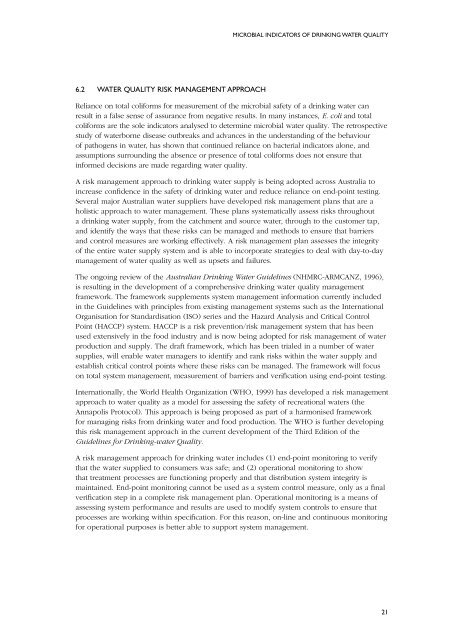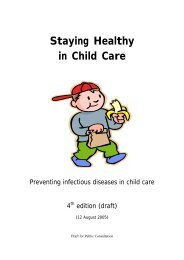Review of Coliforms - National Health and Medical Research Council
Review of Coliforms - National Health and Medical Research Council
Review of Coliforms - National Health and Medical Research Council
You also want an ePaper? Increase the reach of your titles
YUMPU automatically turns print PDFs into web optimized ePapers that Google loves.
6.2 WATER QUALITY RISK MANAGEMENT APPROACH<br />
MICROBIAL INDICATORS OF DRINKING WATER QUALITY<br />
Reliance on total coliforms for measurement <strong>of</strong> the microbial safety <strong>of</strong> a drinking water can<br />
result in a false sense <strong>of</strong> assurance from negative results. In many instances, E. coli <strong>and</strong> total<br />
coliforms are the sole indicators analysed to determine microbial water quality. The retrospective<br />
study <strong>of</strong> waterborne disease outbreaks <strong>and</strong> advances in the underst<strong>and</strong>ing <strong>of</strong> the behaviour<br />
<strong>of</strong> pathogens in water, has shown that continued reliance on bacterial indicators alone, <strong>and</strong><br />
assumptions surrounding the absence or presence <strong>of</strong> total coliforms does not ensure that<br />
informed decisions are made regarding water quality.<br />
A risk management approach to drinking water supply is being adopted across Australia to<br />
increase confidence in the safety <strong>of</strong> drinking water <strong>and</strong> reduce reliance on end-point testing.<br />
Several major Australian water suppliers have developed risk management plans that are a<br />
holistic approach to water management. These plans systematically assess risks throughout<br />
a drinking water supply, from the catchment <strong>and</strong> source water, through to the customer tap,<br />
<strong>and</strong> identify the ways that these risks can be managed <strong>and</strong> methods to ensure that barriers<br />
<strong>and</strong> control measures are working effectively. A risk management plan assesses the integrity<br />
<strong>of</strong> the entire water supply system <strong>and</strong> is able to incorporate strategies to deal with day-to-day<br />
management <strong>of</strong> water quality as well as upsets <strong>and</strong> failures.<br />
The ongoing review <strong>of</strong> the Australian Drinking Water Guidelines (NHMRC-ARMCANZ, 1996),<br />
is resulting in the development <strong>of</strong> a comprehensive drinking water quality management<br />
framework. The framework supplements system management information currently included<br />
in the Guidelines with principles from existing management systems such as the International<br />
Organisation for St<strong>and</strong>ardisation (ISO) series <strong>and</strong> the Hazard Analysis <strong>and</strong> Critical Control<br />
Point (HACCP) system. HACCP is a risk prevention/risk management system that has been<br />
used extensively in the food industry <strong>and</strong> is now being adopted for risk management <strong>of</strong> water<br />
production <strong>and</strong> supply. The draft framework, which has been trialed in a number <strong>of</strong> water<br />
supplies, will enable water managers to identify <strong>and</strong> rank risks within the water supply <strong>and</strong><br />
establish critical control points where these risks can be managed. The framework will focus<br />
on total system management, measurement <strong>of</strong> barriers <strong>and</strong> verification using end-point testing.<br />
Internationally, the World <strong>Health</strong> Organization (WHO, 1999) has developed a risk management<br />
approach to water quality as a model for assessing the safety <strong>of</strong> recreational waters (the<br />
Annapolis Protocol). This approach is being proposed as part <strong>of</strong> a harmonised framework<br />
for managing risks from drinking water <strong>and</strong> food production. The WHO is further developing<br />
this risk management approach in the current development <strong>of</strong> the Third Edition <strong>of</strong> the<br />
Guidelines for Drinking-water Quality.<br />
A risk management approach for drinking water includes (1) end-point monitoring to verify<br />
that the water supplied to consumers was safe; <strong>and</strong> (2) operational monitoring to show<br />
that treatment processes are functioning properly <strong>and</strong> that distribution system integrity is<br />
maintained. End-point monitoring cannot be used as a system control measure, only as a final<br />
verification step in a complete risk management plan. Operational monitoring is a means <strong>of</strong><br />
assessing system performance <strong>and</strong> results are used to modify system controls to ensure that<br />
processes are working within specification. For this reason, on-line <strong>and</strong> continuous monitoring<br />
for operational purposes is better able to support system management.<br />
21

















